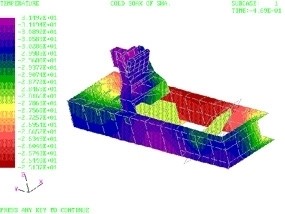Colleagues:
If spherical surfaces didn’t make pretty good images we’d live in a whole
different world. It seems that optics is an art that was just meant to
work. The mechanics? Well, that’s maybe a whole different story.
I recently helped to demonstrate that a proposed optical system could be
made to work. It’s stability requirements were 2 1/2 times tighter than
the earlier system on which the proposal had been based, and the earlier one
had been a challenge in its time. That extrapolation was a risk that the
contractor had to eliminate very early.
So, the CAD engineer and I shared a cubicle. He collected information on
all the stuff that had to go into the system. I created a structural
finite element model to analyze the image stability: I started with the CodeV
prescription, which I read into AEH/Ivory and then imported the Ivory file into Patran; I also
imported into Patran the step-files (and ray bundle) for all the optical
elements; I attached the Ivory
file to the elements (Any time I moved an element I could then read the
resulting motion of the image on the detector); finally, I imported into Patran
the proposed flat honeycomb plate to which the optical elements were to
be mounted. The boring part was over.

And the real fun began. I used Patran
as a design tool: I put cells around each of the optical elements; I tied
the cells down to the flat plate; I ran a 6 DOF rigid body check and a 3 axis
static gravity check in Nastran. Everything behaved well
computationally. But in random vibration it was out of bed by ~3X.
There was work to be done.
With the AEH/Ivory data
imported to Excel I could identify which elements were the big
drivers of the image motions. So, I started beefing up the bracing on
those elements. The CAD engineer was checking my work while he started
his own modeling effort. He guided me in positioning the optical
mountings and I guided him in locating the other services (electronic, thermal,
servo, mechanical) that had to work in proximity to the optics on the inner
gimbal. The bracing and the services all had to fit. Ultimately, we
(he and I) were able to reduce the image motions by over 3X and show safe margin on the stability requirements with
everything on the gimbal.
All of this was done in the opening days of the project. In fact,
if you cannot make the optical system work when the design spaces are
malleable, you will be unlikely to make it work later. It only gets
harder (and I’ve been there too). This early structural concept was
itself malleable and would change over time as all of the disciplines agreed to
the design. It might be months before all the CAD interfaces would be
settled. Meanwhile, the project had a structural concept that promised to
meet the stability requirements and could guide the detail mechanical design.
And an engineering tool for occasional spot-checks
and trade-off studies.
Joy and Happiness!
Ahhh… April.
Al H.
4-16-14








